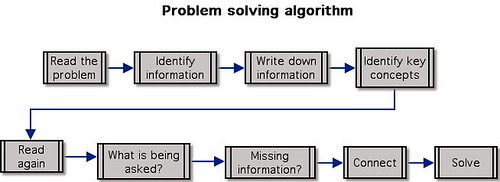As I said in 7 ways to make IT real: #0 Make IT unreal, setting the kids a problem like “Imagine you’re going to open a video shop” is not going to cut it these days. You either need to set problems that are outlandish and obviously unreal, or set them ones which are all too real.
I’d suggest that the best way of doing so is to get the pupils themselves to identify problems. That’s the approach taken by Apps for Good, and it seems to work quite well.
It would probably be a good idea to spend some time discussing/brainstorming what sort of problems technology might solve, and how it might do so. For example, an obvious problem might be lack of information, or the absence of a central point where you can go for the information. In my case, one of the things I tend to look for when I am in an area is a nice café with free wireless, as opposed to so-called internet cafés. An app or a website that listed such places would be pretty useful.
 A problem-solving algorithm, by Coach_Robbo http://www.flickr.com/photos/coachrobbo/
A problem-solving algorithm, by Coach_Robbo http://www.flickr.com/photos/coachrobbo/
Perhaps more seriously, a central point of reference for matters concerning e-safety would be useful. (Unless I’ve missed a meeting, the last time I looked there were loads of organisations dealing with this subject, but no obvious central reference point. True, they all reference each other, and the UK Safer Internet Centre does a good job of collating information, but I’m not aware of a website or app which is indisputably the starting point for anyone needing advice.)
Here are some notes on what I think would be useful areas to explore with pupils, and on which to provide some guidance:
Where can you find problems?
In the obvious places:
- Home
- School
- Your locality
- Your country
- The world
Whose problems are they?
Well, the problems do not have to be the pupils’ own. There’s scope for doing surveys and other types of research in order to find out what the most commonly perceived problems are in a particular area or context. Conducting surveys would be a good thing to do because:
- It will enable the pupils to identify genuine issues
- Pupils can convene a user group that will comment on their app/website/program etc while it is a work in progress
- Pupils can present their findings and their solution to, first, the people they surveyed and then to a wider audience.
At each of these stages useful skills have to be applied.
How can technology help?
The kind of things a good website, app or computer application can do would include the following:
- Do something faster, perhaps through automating a process…
- …and/or more efficiently
- Present data in an understandable form (ie convert data into information)
- Connect disparate pieces of data.
- Highlight areas of concern, such as through conditional formatting in a spreadsheet…
- … or be even more proactive, such as by sending you a text message when certain conditions are satisfied
None of the lists above is intended to be definitive or exhaustive. But hopefully they will prove useful starting points.
